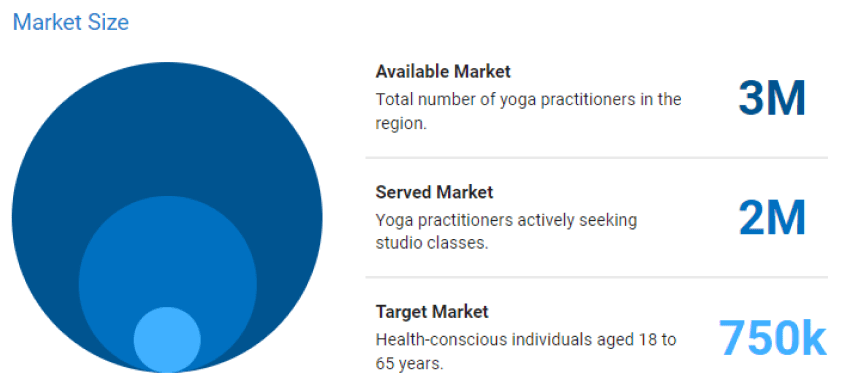Market analysis is the foundation upon which the success of your business relies.
Whether you are a seasoned entrepreneur planning to enter a new geographical market or an emerging startup struggling to place together your business plan—a thorough understanding of the market, customers, and competitors is essential for a business to thrive successfully.
Now, writing a market analysis for your business plan is quite a challenge. But with this step-by-step guide, we have made the entire process quite simple and easy to follow.
Also, get tips to write this section and our curated market analysis example for a business plan.
Ready to dive in? Let’s get started.
Key Takeaways
- Conducting a market analysis helps in understanding your industry, target market, and competition.
- Key components include industry description, target market demographics, market need, competition analysis, and regulatory environment.
- A well-executed market analysis supports strategic decision-making and demonstrates business viability to stakeholders.
What is Market Analysis?
Market analysis is a detailed analysis of your business’s target market and the competitive landscape within a specific industry. It is an important section of your business plan offering a thorough insight into the state of the industry, the potential target market, and your business’s competition.
A well-targeted market analysis forms the base upon which the foundation of your business relies. It assures the readers that you have a thorough understanding of the market you are about to enter.
Why should you Conduct Market Analysis?
Wondering how market analysis will contribute to the success of your business? Well, check these benefits of conducting a comprehensive market analysis for your business:
1. Reduces the risk
Instead of operating on instincts and gut feelings, market research enables you to make decisions based on data and analysis. When you know with surety what works and what doesn’t, you will make decisions that are more likely to succeed than fail.
To summarize, having an in-depth market analysis will reduce the risks associated with starting a business in a thriving marketplace.
2. Identifies emerging trends
A market analysis identifies emerging market trends and patterns and thereby helps you stay at the top of the competition. Not only the trends, but you can also identify challenges that may potentially arise in your business and design a pivot plan.
3. Assist in product development
A detailed analysis of the target market, industry, and competitors helps you create the product that the customer will be willing to buy. The analysis will not only assist in product development, but also with pricing, marketing, and sales strategies to ensure thriving business conditions.
4. Optimize your target market
Your business is not for everyone and the sooner you realize this the better. A target market analysis helps in understanding who your potential customers are and accordingly strategize your marketing efforts to attract them.
5. Establishes evaluation benchmarks
Market analysis benefits your business by offering evaluation metrics and KPIs. Such metrics help in measuring a company’s performance and its edge over the competitors.
Lastly, a thorough market analysis is quintessential if you are planning to secure funds. As a matter of fact, it is non-negotiable.
Now that you know how important having a market analysis section is, let’s learn a detailed way of conducting such analysis.
How to Simplify Your Market Analysis?
Market analysis is a broad concept covering a wide range of details. There’s no denying that it is a tiring task requiring extremely dedicated efforts.
From understanding the purpose of research to undertaking surveys, gathering data, and converting it into worthy analysis—the research itself is a lot for an individual to cover.
Upmetrics market analysis tool kit includes a variety of guidebooks and templates that will help you with target customer analysis, surveys, and competitor surveys.
The documents will guide you in a strategic direction to conduct qualitative research and analysis. They are well-crafted and quite simple to follow even for someone with no prior experience at market analysis.
Got it? No more side talking, let’s get straight to what you are here for.
How to Conduct a Market Analysis?
Conducting thorough market research and analysis could be a hassle, but not with this easy-to-follow 7-step guide. Let’s get over it.
1. Determine your objective
When you write a business plan, market analysis is going to be one prominent component.
However, it is important to know the clear objective of conducting such analysis before you kickstart.
For instance, are you planning to acquire funding from investors or are you conducting this research to test the viability of your business idea? Are you looking to add a new product segment to your business or are you looking to expand in other states and countries?
 Having a clear objective in mind will help you move in a strategic clear direction. Moreover, you won’t spend unnecessary effort and time on detailed analysis when you have a clear objective in hindsight.
Having a clear objective in mind will help you move in a strategic clear direction. Moreover, you won’t spend unnecessary effort and time on detailed analysis when you have a clear objective in hindsight.
That being said, the purpose of your market analysis will determine the extent and scope of research essential for your business.
Spend more time researching, less writing
Make business plans in minutes with AI
Plans starting from $14/month

2. Conduct an Industry Analysis
In this part of your analysis, you will highlight the state of the current industry and show where it seems to be moving. Investors would want to know if the industry is growing or declining, so present accordingly.
This section should include metrics for market size, projected growth, average market growth rate, product life cycle, and market trends.
Ensure that you gather data from highly authoritative sites like the US Bureau of Labor Statistics (BLS), Bureau of Economic Analysis, and industry publications to make your analysis.
To make this section enriching and meaningful, begin with a macro industry overview and then drill down to your specific market and business offering as thorough details as possible.
3. Identify your target audience
This section of your market analysis is dedicated to your potential target customers.
And, although your product might be suitable for everyone, there is a high possibility that not all of them will be your customers due to many reasons.
It is therefore better to target a specific category of customers to grow your business effectively and efficiently.
Now, you can begin by creating a buyer’s persona of your ideal customer describing their demographic and psychographic details. This includes talking about the age, gender, location, income, occupation, needs, pain points, problems, and spending capacity of your target customer.
You can conduct surveys, interviews, and focus groups, and gather data from high-end sources to get essential details for a customer profile.
However, make sure that you dig into details to make this section resourceful for business planning and strategizing.
4. Analyze your competitors
Competitive analysis is the most important aspect of your market analysis highlighting the state of the competitive landscape, potential business competitors, and your competitive edge in the market.
Now, a business may have direct as well as indirect competitors. And while indirect competition won’t affect your business directly, it definitely would have an impact on your market share.
To begin this section, identify your top competitors and list them down.
Conduct a SWOT analysis of your top competitors and evaluate their strengths and weaknesses against your business.
Identify their USPs, study their market strategies, understand how they pose a threat to your business, and ideate strategies to leverage their weaknesses.
Don’t undervalue or overestimate your competitors. Instead, focus on offering a realistic state of competition to the readers.
Additionally, readers also want to know your strengths and how you will leverage a competitive edge over your competitors. Ensure that this section highlights your edge in terms of pricing, product, market share, target customer, or anything else.

Want to create a SWOT analysis for your business?
Craft a powerful SWOT Analysis in just minutes using our user-friendly and free online SWOT Analysis Generator Tool!
5. Calculate your market share
The analysis section of your business plan must also include details of your market share.
If your estimated market share is not big enough, chances are your business idea might not be profitable enough to pursue further.
Now, you can use these proven metrics to forecast your market share:
TAM (Total available market)
It represents the total demand available in the market. In other words, it is the maximum amount of sales or revenue the market has to offer.
SAM (Serviceable available market)
It represents the segment of TAM that you can obtain with your solution within your limitations. These limitations can be geographical location, business model, type of product, etc.
SOM (Serviceable obtainable market)
It represents the segment of SAM that you can realistically capture after considering your competitors, customer preferences, production capabilities, etc.
SOM is your estimated market share. Once you have calculated it, you can actualize it via suitable pricing strategies.
Apart from this method, you can also use other approaches like top-down, bottom-up, and triangulation to estimate your market share.
However, whatever method you use, ensure that the projections are realistic and attainable.
6. Know the regulations and restrictions
Before entering a new market or starting a new business, you need to know the regulations and restrictions in your industry.
Understanding these can help you stay out of legal pitfalls and inspire confidence in prospective investors.
Some of the regulations you need to know are:
- Government policies
- Tax regulations
- Trade policies
- Employment laws
- Environmental regulations
- Security and privacy
- Protection of intellectual properties
Include these details in your market analysis section to help readers understand the risk value and federal regulations associated with your business.
7. Organize and implement the data
After completing your research, it’s now time to make sense of all the data you’ve gathered.
There is no strict structure when it comes to organizing your market analysis. However, ensure that your analysis includes specific sections for objective, target market, and competition.
Focus on creating an easy-to-digest and visually appealing analysis section to help the readers gather essential essence.
Now, it’s a waste if you are not putting all this research to some use. Identify the business areas where you can implement your research be it product development, exploring the new market, or business operations, and develop strategies accordingly.
All in all lay the foundation of a successful business with a thorough and insightful market analysis. And, you can do it by having an organized market analysis section in your business plan.
Create visually appealing business plan with our
AI Business Plan Generator
Plans starting from $14/month

Tips to Write Your Market Analysis
After conducting thorough market research, it is important to present that information strategically in a business plan to help the readers get meaningful insights.
Well, here are a few tips to help you write the market analysis for a business plan.
1. Stay in context
Remember the objective of your market analysis and stick to it. Keeping the context in mind, identify what essential information to present and back them up with high-end sources.
Also, tie your data with essential analysis to show how your business would survive and thrive in the market.
2. Add visual graphics
No one prefers shifting through pages of pure text content. Graphics and visuals make your market analysis easy to absorb and understand. You are more likely to capture readers with visual attractiveness rather than risk their attention with pure textual content.
3. Offer an engaging summary
Offer readers a quick overview of your detailed market analysis by including a summarizing text. A summary will help readers gather a macro perspective before diving deep into hard facts and figures.
4. Avoid fluff and repetition
Ensure that everything you present in your market analysis section holds a meaning. Avoid adding inessential and fluff information.
To best identify whether or not the information is essential for the reader, ask this simple question: Will the reader learn something about my business’s market or its customers from this information?
If not, the information is most likely inessential. And, those were some quick tips to ensure effective market analysis for your business plan.
Market Analysis in a Business Plan Example
Before we conclude, check out this market analysis example from Upmetrics’ sample yoga studio business plan.
Business Name: Lotus Harmony
Location: Green Valley
Core Objective for Market Analysis
Our goal for the market analysis at Lotus Harmony is straightforward: to deeply understand what the Green Valley community seeks in yoga and wellness. We’ll closely look at local demand and the competitive scene, shaping our services to precisely meet community needs. This approach promises to make Lotus Harmony a distinct and beloved wellness destination in our neighborhood.
Industry Overview of the Green Valley Yoga Market
Market Size:
Green Valley is home to nearly 1M yoga enthusiasts, predominantly aged 25-45. This demographic suggests a robust market for yoga and wellness, ripe for a studio that offers diverse and inclusive programs.
Projected Growth:
The yoga community is expected to grow by 5% annually over the next five years. This growth is driven by an increasing interest in holistic health, presenting a fertile ground for a new yoga studio to thrive.
Market Trends:
A rising trend is the demand for comprehensive wellness services, including mindfulness and nutrition, alongside traditional yoga. Specialized classes like prenatal yoga are also gaining popularity, signaling opportunities for niche offerings.
By tapping into these insights, a new yoga studio in Green Valley can strategically position itself as a premier wellness destination, catering to the evolving needs of the community.
Target Market Analysis for Lotus Harmony
Lotus Harmony Yoga Studio’s ideal customers are mainly Urban Millennials and Gen Z (ages 18-35) who prioritize:
- Wellness and mindfulness as part of their lifestyle.
- Affordable, holistic health experiences blending physical and mental well-being.
- Convenience with flexible class schedules and online access.
- Community and sustainability, preferring spaces that offer personal growth and eco-consciousness.
- A welcoming atmosphere that supports inclusivity and connection.
Competitive Landscape for Lotus Harmony
Lotus Harmony’s success relies on understanding consumer preferences and income, securing prime locations, attracting patrons, and offering quality services. Competing with gyms, wellness centers, and home fitness, it positions itself as a holistic wellness choice, aiming to stand out in Green Valley’s wellness scene.
Market Share for Lotus Harmony

Regulatory Requirements for Lotus Harmony
Here are a few aspects of legal compliance essential for Lotus Harmony:
- Business Registration and Licensing
- Zoning and Land Use Permits
- Health and Safety Compliance
- Professional Liability Insurance
- Instructor Certifications
- Building Safety Certificates
- Accessibility Compliance
- Tax Registration
Final Thoughts
It takes an extremely dedicated effort to undertake market research and craft it into a compelling analysis. However, it’s a worthy business planning effort that will set a cornerstone of success for your business.
Don’t worry. You don’t need to spend days figuring out what and how to write your market analysis. Upmetrics, an AI-powered business planning app, will help you write your overall business plan in less than an hour.

